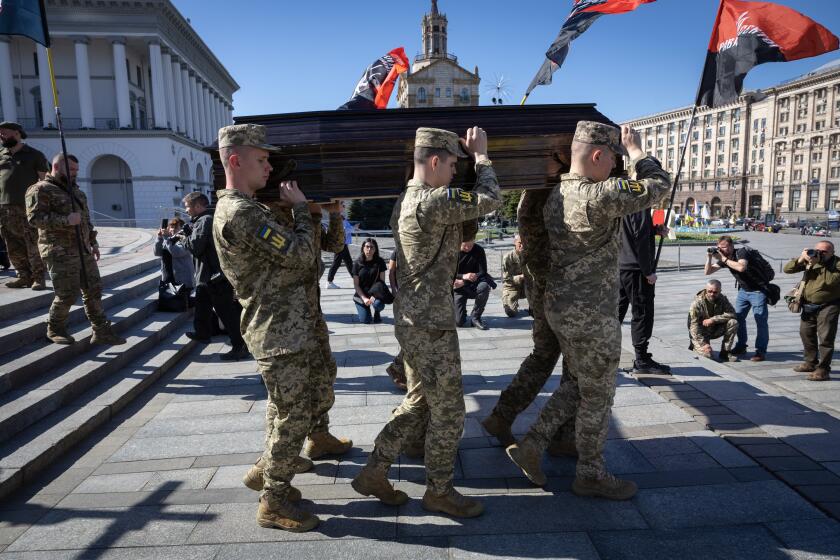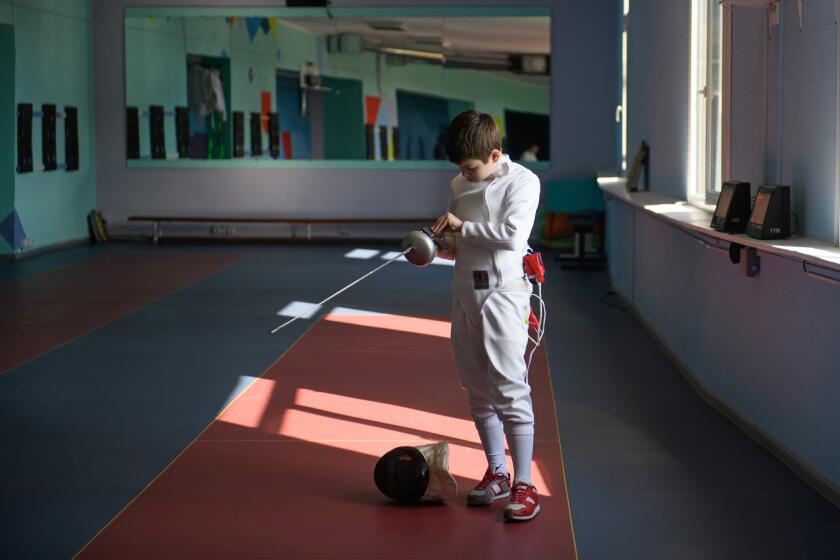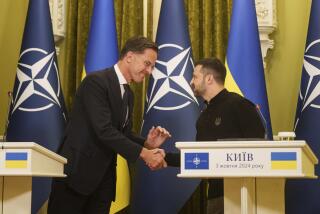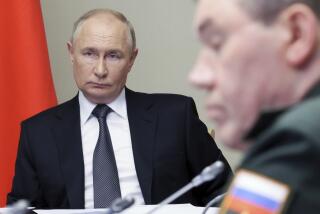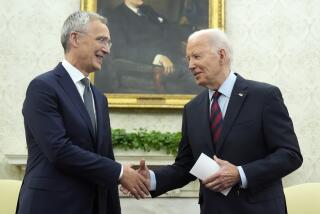NATO chief chides alliance countries slow to deliver aid to Ukraine
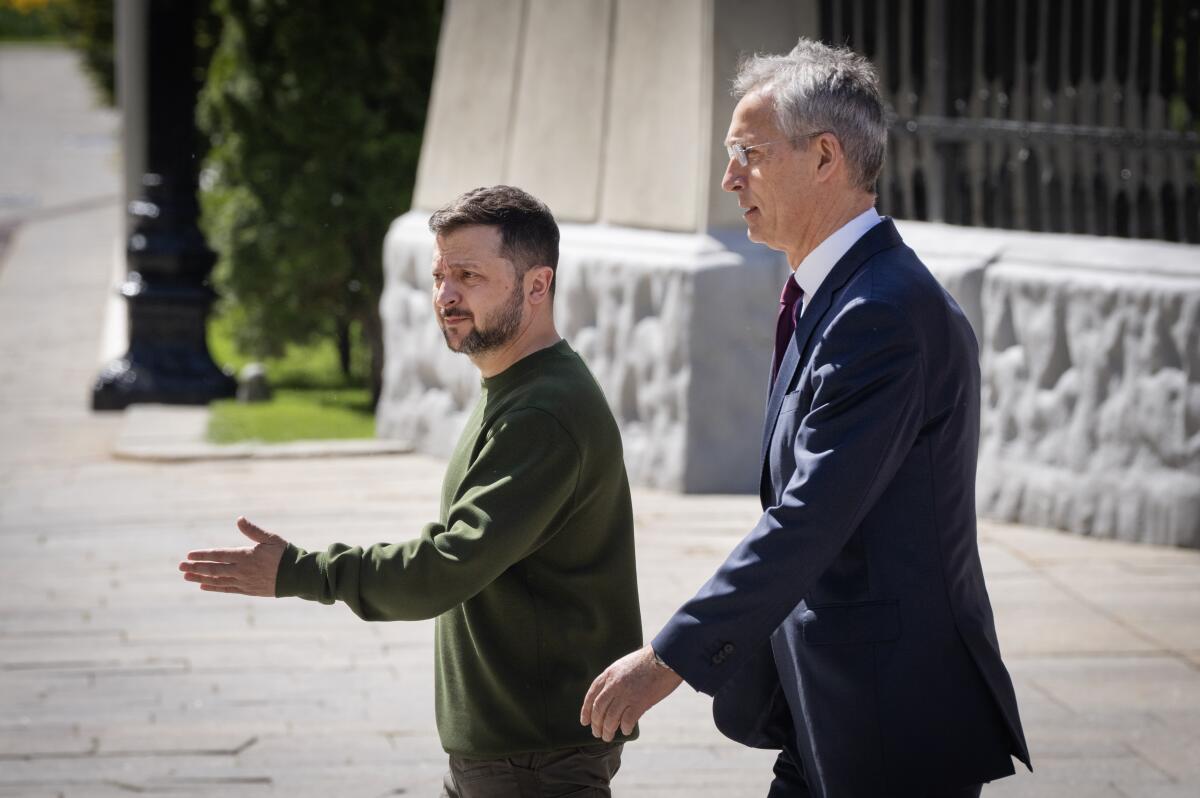
- Share via
KYIV, Ukraine — NATO countries haven’t delivered what they promised to Ukraine in time, the alliance’s chief said Monday, allowing Russia to press its battlefield advantage while Kyiv’s depleted forces wait for Western military supplies to arrive.
NATO Secretary General Jens Stoltenberg said that “serious delays in support have meant serious consequences on the battlefield” for Ukraine.
“NATO allies have not delivered what they promised,” Stoltenberg said at a news conference in Kyiv with Ukrainian President Volodymyr Zelensky, referring to delays by the U.S. and Europe in sending weapons and ammunition.
Ukraine’s troops were compelled to make a tactical retreat from three villages in the eastern region, where the Kremlin’s forces have been making incremental gains against their weaker opponent, Ukraine’s army chief said Sunday. The Russian Defense Ministry claimed Monday its forces had also taken the village of Semenivka.
“The lack of ammunition has allowed the Russians to push forward along the front line. Lack of air defense has made it possible for more Russian missiles to hit their targets, and the lack of deep strike capabilities has made it possible for the Russians to concentrate more forces,” Stoltenberg said.
Could Ukraine lose the war? Once nearly taboo, the question hovers in Kyiv, but Ukrainians believe they must fight for their lives against Putin’s troops.
Ukraine and its Western partners are in a race against the clock to deploy critical new military aid that can help check the recent slow and costly but steady Russian advance across eastern areas, as well as thwart drone and missile attacks.
Zelensky said new Western supplies have started arriving, but slowly. “This process must be speeded up,” he said.
Though the 600-mile front line has shifted little since early in the war, the Kremlin’s forces have in recent weeks edged forward, especially in the Donetsk region, by sheer weight of numbers and massive firepower used to bludgeon defensive positions.
Kyiv’s Western partners have repeatedly vowed to stand with Ukraine “for as long as it takes.” But vital U.S. military help was held up for six months by political differences in Washington, and Europe’s military hardware production has not been able to keep up with demand. Ukraine’s own manufacturing of heavy weapons is only now starting to gain traction.
Russia is a far bigger country than Ukraine, with greater resources to draw on. It has also received weapon support from Iran and North Korea, the U.S. government says.
Drawn-out Ukrainian efforts to mobilize more troops, and the belated building of battlefield fortifications are other factors currently undermining Ukraine’s war effort, military analysts say.
Kharkiv, Ukraine’s second-largest city, is facing intense Russian airstrikes, but its residents are defiant. “We can stand up, no matter what they do,” one said.
Stoltenberg said more weapons and ammunition for Ukraine are on the way, including Patriot missile systems to defend against the heavy Russian barrages that smash into the power grid and urban areas.
That additional help may be needed as Ukrainian officials say Russia is assembling forces for a major summer offensive, even if its troops are making only incremental gains at the moment.
“Russian forces remain unlikely to achieve a deeper operationally significant penetration in the area in the near term,” the Institute for the Study of War said in an assessment late Sunday.
Even so, the Kremlin’s forces are closing in on the strategically important hilltop town of Chasiv Yar, whose capture would be an important step forward into the Donetsk region.
Donetsk and Luhansk together form much of the industrial Donbas region, which has been gripped by separatist fighting since 2014, and which Putin has set as a primary objective of the Russian invasion. Russia illegally annexed areas of the Donetsk, Kherson, Luhansk and Zaporizhzhia regions in September 2022.
Lawless writes for the Associated Press.
More to Read
Sign up for Essential California
The most important California stories and recommendations in your inbox every morning.
You may occasionally receive promotional content from the Los Angeles Times.
